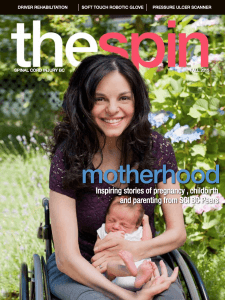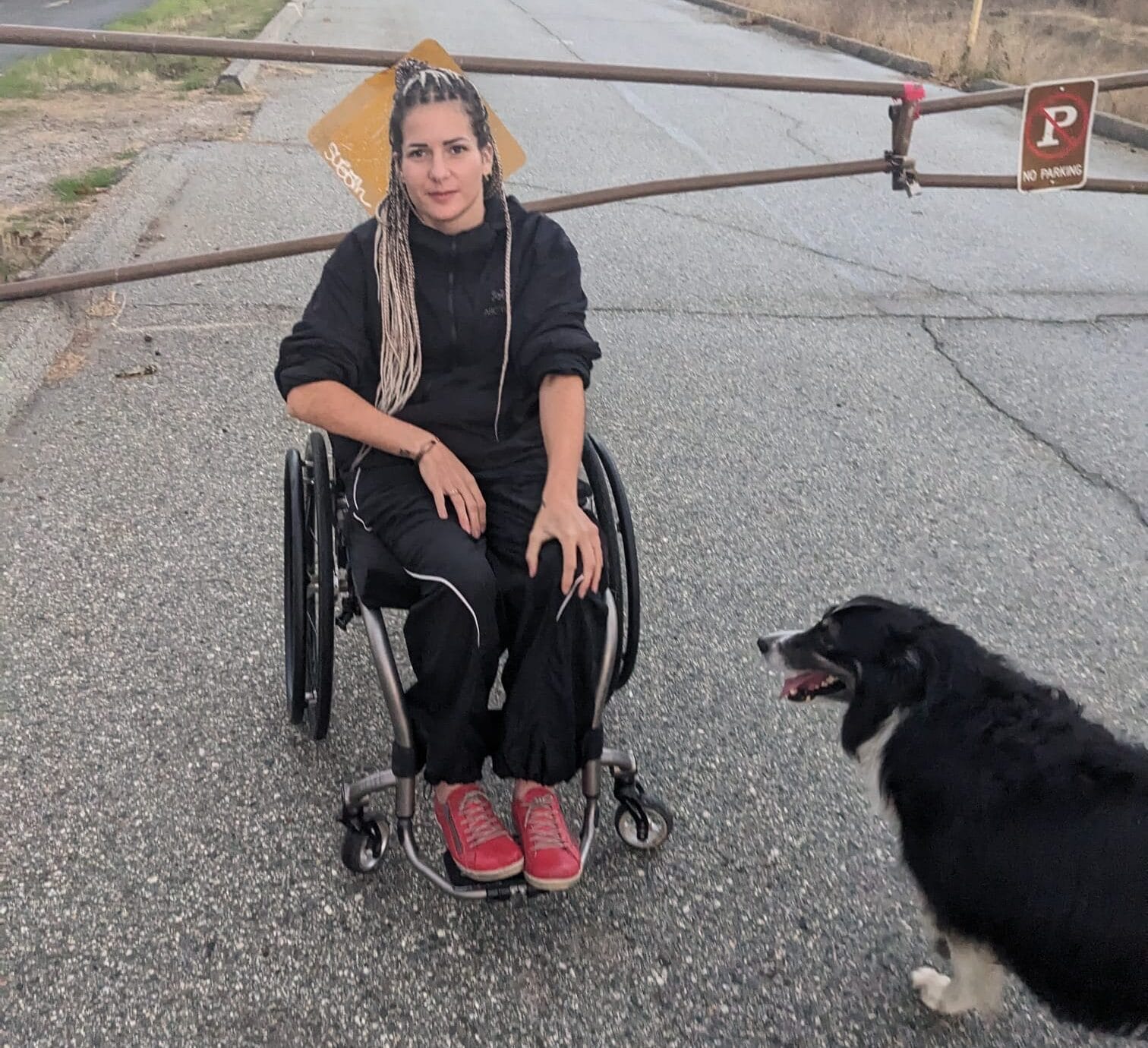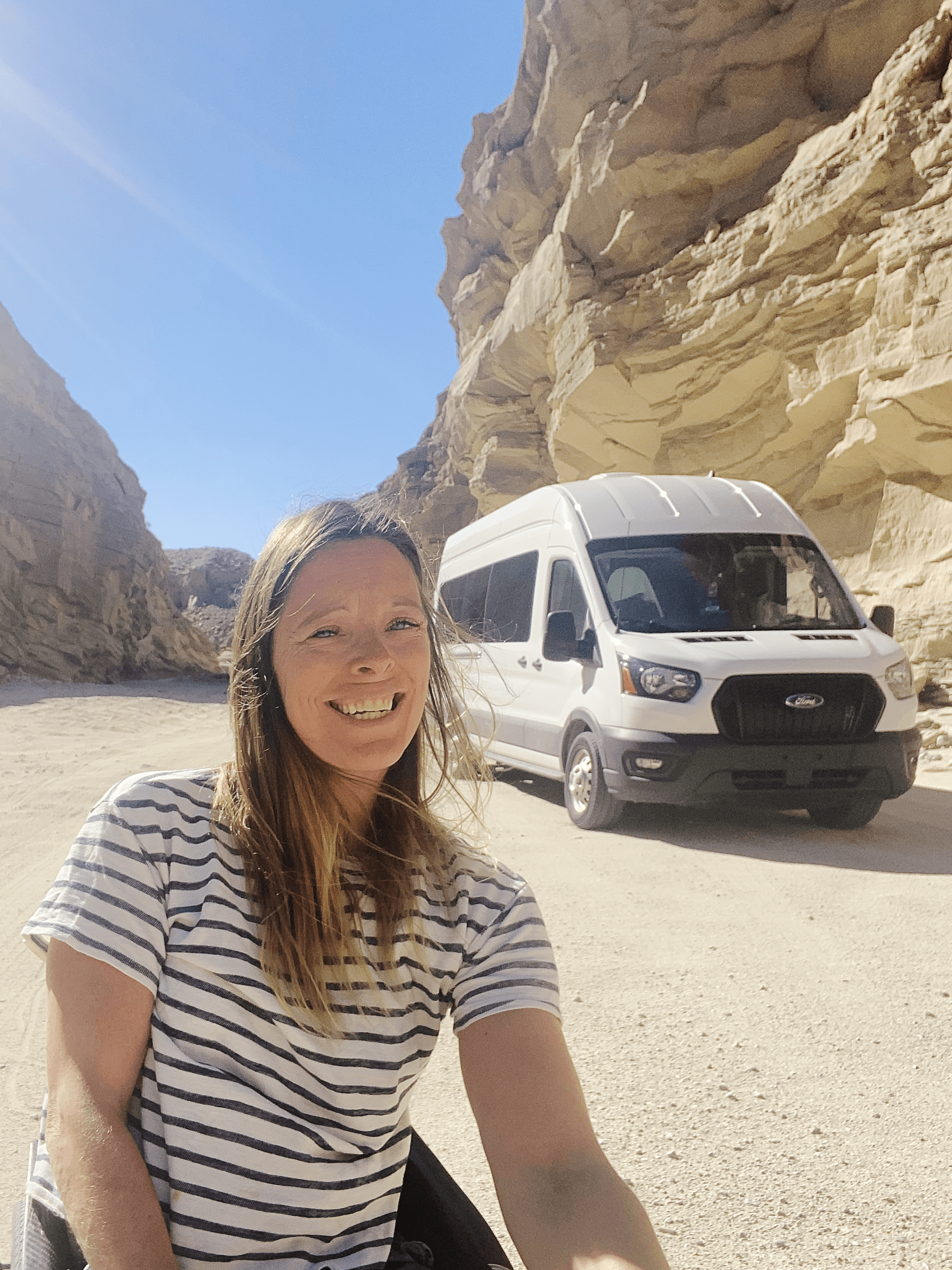
Here’s a couple of interesting facts: a woman’s ability to get pregnant after injury is approximately the same as prior to injury, and most women with SCI do not require any special services or procedures to get pregnant.
Still, women with SCI who are considering getting pregnant have a lot to think about—from medications, mobility, and physical wellbeing during pregnancy, to labour, delivery, postpartum and beyond. And finding information related specifically to SCI and pregnancy can be a real challenge. That’s why Spinal Cord Injury BC has partnered with the BC Women’s Hospital and Health Centre, Vancouver Coastal Health, and the Rick Hansen Institute to bring you a comprehensive SCI pregnancy resource. Our new pregnancy and SCI booklet, available for download at sexualhealth.sci-bc.ca, highlights a number of things for women with SCI and their families to keep in mind, from preconception until after the baby is born, to maintain health and wellness for themselves and their babies.
We’ve been told already that the guide is invaluable. But with our long history as a “peers helping peers” organization, we also know that, sometimes, the best advice and encouragement can come from others who have travelled the same road. That’s why we’ve asked another set of experts—mothers from our own SCI community throughout BC—to share their pregnancy adventures and anecdotes with us. Our five mothers range from complete to incomplete SCI, from new moms to second-time moms, and from an expecting mom to the mother of a young bride-to-be. They all have one thing in common: after a string of challenges, they experienced a reward greater than any of them anticipated.
Jessica Vliegenthart (pregnant)
I think if you’re prepared for your life to change rather drastically without much notice, you’ll be fine.
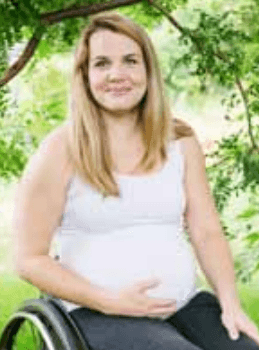
As I write this, I’m 33 weeks pregnant. My due date is September 19, 2015, but I will be induced at around 37 weeks, which will be sometime at the end of August.
I’m a T9 complete paraplegic with no sensation or movement below my line of injury. I’ve been married for six years and have just established a career as a lawyer, which is a demanding field, so while this pregnancy was definitely planned I was a bit nervous heading into it because my life is jam-packed already! Obviously, I know that things will change when the baby is born, but I’m also very aware that pregnancy is a serious medical event that can result in unexpected things—which it has for me.
I knew that I would have to go off some of the medication that makes my life bearable. My physiatrist and I struggled with finding a short-term solution and I went through some very, very painful months with little to no sleep until we got it relatively sorted out. I still have a lot of pain, and sleep is elusive, but not as lacking as it was when I first went off the medication. I think if my life was a bit more relaxed, and I wasn’t working a demanding job with long hours, going off the medication would have been less of an issue because I could have adapted my days to feeling terrible. As it was, I just pushed through it.
I have no expectations for the birth process. My plan is this: Do what they tell me. I’m quite comfortable letting the docs tell me what is best. They will be giving me a prophylactic epidural to ensure I don’t become dysreflexic. I’ve never had dysreflexia before, but my doctors are worried that labour could trigger it, so better safe than sorry.
The biggest challenges I’ve had in pregnancy (so far) have been mobility changes and dealing with my bladder. Some transfers have become impossible, and it’s frustrating. For example, I haven’t been able to transfer into my SUV since 30 weeks. It’s not that I’m not strong enough, it’s that my belly is now physically in the way and I can’t lean far enough forward to make the jump. I didn’t expect my belly to be the problem, but it really is. Think of all the transfers you normally do with your stomach very close to your thighs—for me it was a lot! Now imagine you have a watermelon in between your legs and your torso. I am much less flexible and bendy than before.
My bladder has also been a challenge. I normally get Botox every five to six months to help with my neurogenic bladder. This is not an option when pregnant, so I’ve had to increase how often I go to the washroom. I won’t lie—it’s exhausting. Aside from actually meeting our future son or daughter, I am most excited about getting my bladder back to normal!
I have only gained 23 pounds thus far. I played basketball and tennis right up to six months pregnant and would have continued, but medically could not. My appetite increased, but I continued to eat the same things I always have, so weight gain has been pretty minimal. My chair size has not been affected by this weight gain (it’s mostly in my belly).
Preparing for pregnancy was fairly simple, aside from figuring out medications—and I was prepared for that to be a challenge. I think if you’re prepared for your life to change rather drastically without much notice, you’ll be fine. As pregnancy and SCI is still rare, things can and do come up. For example, I’ve been hospitalized for observation for the past three weeks because I’ve had regular contractions. An able-bodied woman would have sensation to know if she’s in real labour, whereas I do not—so into the hospital for me.
Overall, my pregnancy was fairly easy until 29 weeks, when I was admitted to hospital. Going off the medication I had been on for 10 years was literally agonizing, but it was to be expected and occurred before I got pregnant. I think the most challenging time of pregnancy for SCI moms will be the last eight weeks, as it is for the majority of women.
As for pregnancy timing, I will do everything in my power to avoid a late summer baby the next time around. It’s very hot and sweaty. It’s also really frustrating to be stuck inside when it’s beautiful out!
Ed. Note: On August 31, Jessica and Jon welcomed their baby boy, Remy. Congratulations!
Yasaman Best and Alex (three months)
After my first meeting with the Maternal Fetal Medicine (MFM) team at the BC Women’s Hospital, I told my husband that, for the first time, I felt included.
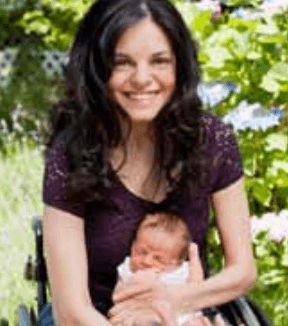
Our son was born in June—his name is Alexander Nima Best, but we call him Alex. At first, the idea of getting pregnant terrified me. I was injured 13 years ago, when I was 21. My injury level is C6-C7— I’m complete mobility-wise but incomplete sensation-wise. I was worried that my SCI would hurt the baby. I was worried that my transfer, leaning forward, would hurt the baby. I was worried about how I could take care of the baby when my husband goes back to work. I read many pregnancy books and articles, but always felt left out. None of the books answered my questions; none of the examples and information included a mother with an SCI.
Before getting pregnant, I met with sexual health clinician and RN Shea Hocaloski from Vancouver Coastal Health’s Sexual Health Rehabilitation Service. She referred me to the amazing Maternal Fetal Medicine (MFM) team at the BC Women’s Hospital. I discovered that this team has so much experience with pregnancy and SCI. The doctors and nurses were completely aware of the related risks: autonomic dysreflexia, UTIs, low blood pressure and other issues. After my first meeting, I told my husband that, for the first time, I felt included.
During my pregnancy, I tried to eat healthy and stay active. Fortunately, maternity pants are easy for a quad to put on—there is no button or zipper, only an elastic waist.
The OTs at GF Strong were amazing. They help you adapt based on your limitations, so you can be as independent as possible. Danielle, my OT, even adapted my changing table, baby carrier, and baby clothes so I can do everything by myself. The Tetra Society also modified our crib so I can easily use it.
The third trimester was the hardest for transferring—you feel heavy, you can’t lean forward much, and you feel so helpless. Also, I developed a UTI, and had to be hospitalized at 34 weeks when the infection became sepsis, which was very scary.
I was apprehensive about giving birth. I have had many surgeries—including Harrington rods from my scoliosis surgery, which I had 10 years prior to my injury—and I didn’t want the birth of my son be yet another surgery.
I met with the knowledgeable anaesthesia team at BC Women’s Hospital beforehand. They told me that they must use an epidural due to risk of autonomic dysreflexia during the birth. Usually, epidurals are not effective when Harrington rods are present, but the team said they were willing to give the epidural and a C-section a try.
However, my baby decided to surprise me and came three weeks early! I was working until 36 weeks. At 37 weeks I went to hospital thinking I had a UTI and was leaking. It turned out my water had broke and that my baby was coming. Luckily, Melanie Basso, one of the nurses at the BC Women’s Hospital, had written a very detailed birth plan so there were no surprises for the nurses and doctors on call. And, luckily, the epidural worked. My son was born eight hours later by natural
birth, with the help of forceps.
The moment my son was born, my life changed forever. I know it won’t be a cakewalk but I feel incredibly lucky to have the support of my loving husband, Robert, and my family. Robert, who I met four years after my injury, has accepted that he will have more responsibilities: midnight diaper changes, helping with the baby, doing chores around the house. I’m fortunate to have a supportive partner to be there for me emotionally and physically. And I’m grateful to have a mom and dad who went above and beyond to help me during my pregnancy, and continue to do so now that Alex is born.
I’m also so lucky to have access to such incredible health professionals, including Dr. Stacey Elliott and the team at the Sexual Health Rehabilitation Service, the Maternal Fetal Medicine team, and the incredible OTs at GF Strong.
Being a mom is the most amazing experience.
Shawna McCardell and Rachel (17 months)
I do my best to adapt and balance motherhood and rehabilitation.
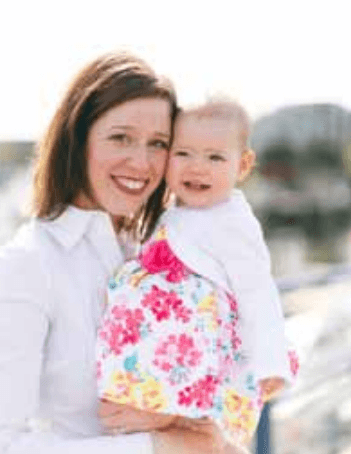
Becoming a mother has been one of my greatest joys. While I’ve certainly faced challenges through the journey, just basking in my little girl’s smile makes it worthwhile.
Just over four years ago, I had a complete disc herniation at L5-S1 which compressed the nerves of my spinal column. After surgery, I was left with cauda equina syndrome. Years of physiotherapy, walking aids and hard work enabled me to slowly regain most of my mobility, but I struggle daily with neuropathic pain and am unable to move quickly.
Despite the pain, I was determined to not let my disability stop me and my husband from starting a family. Before getting pregnant, I felt I had to stop using my pain medication. It took time to recognize my limitations and find ways to manage the pain, but through the help of my doctors I managed to stay off prescription medication throughout my pregnancy.
I also expected to be pretty inactive throughout the pregnancy. While I was more limited and sore toward the end, it was manageable. A good diet and Pilates with a physiotherapist helped me stay as strong as possible.
My biggest concern was the delivery itself. Doctors felt a natural birth was too risky for my vulnerable condition, so I knew I would be having a Caesarian birth. Unfortunately, the next surprise was to learn that an epidural was also too risky, and I had to deliver under general anaesthetic. It was painful to learn that I would not be able to witness or really experience my daughter’s birth. Nevertheless, the procedure went smoothly and my husband and I welcomed a beautiful little girl in April 2014.
Life with a child has its challenges. I struggled to focus on my recovery while caring for my baby. I have always tried to predict what I would struggle with and problem solve ahead of time. For example, I was fortunate enough to have my crib modified through the Tetra Society so I could easily use it without straining my body. I was also very careful when selecting a stroller, paying particular attention to height and ease of movement.
My daughter is now 17 months old. As she gets heavier, busier, quicker and more stubborn, the challenges change, but I do my best to adapt and balance motherhood with rehabilitation. I am also lucky to have a supportive husband, family and friends for when I need time to recover—or when our daughter needs to be chased!
Karen Hodge and Colin (6) and Laura (2)
After my first pregnancy, I vowed that other moms shouldn’t have to experience the same uncertainty and isolation that I had felt.

I always wanted to have children. Like many couples, after a few years together my husband and I decided to start a family.
Unlike most people, I have lived with an SCI since I was a teenager, when I developed an arteriovenous malformation in my spine. Fortunately, I’m pretty determined, and strive to live my life to the fullest. Pregnancy for me was the next step on this journey.
Prior to becoming pregnant, I was excited and eager to learn as much as I could about pregnancy and any special considerations related to my SCI. My friends were all easily finding fertility and pregnancy information online, so I figured I would have the same experience. However, I soon discovered there was very little information available. I began to feel quite isolated and alone. Most health care professionals I spoke to had very limited information.
Fortunately, I am happy to say I am now the proud mom of two healthy children—one boy and one girl. Both pregnancies had their challenges, but I loved the feeling of the babies kicking and growing in my belly. And, in the end, I did not require intrusive interventions to help either of them enter safely into this world.
After my first pregnancy, I vowed that other moms with SCI shouldn’t have to experience the same uncertainty and isolation that I had felt. I contacted the various professionals I’d met who had the most clinical experience in this area. Together, we created the SCI and Pregnancy Perinatal Interest Group, of which SCI BC is a participant. This small, dedicated group of individuals has worked hard to help increase knowledge and raise awareness. We hosted a full day workshop for interested health care professionals, researchers and women with SCI, created a YouTube video to raise awareness that pregnancy after SCI is possible (http://goo.gl/78LVFr), and published a client-oriented brochure and information booklet.
So how do I find the time to reach out to other women with SCI while juggling work, raising two kids, and trying to find time for the occasional date night with my husband? I do this work in the hopes that women who are thinking about pregnancy will realize that they can do it and that they are not alone. Motherhood is an amazing rollercoaster journey of excitement, fear, joy, frustration, and love. If you decide to become a mother, there are many of us that would like to welcome you to the crazy world of motherhood and we are more than happy to help show you the ropes.
Christie Ewen and Alaura (25)
The funny thing is, when they handed me my baby girl, I felt no pain at all.
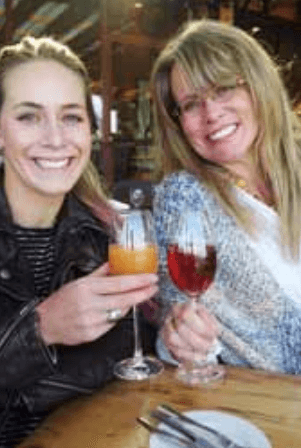
I’ll never forget the day that we found out that I was pregnant—I was overjoyed! It was really a great pregnancy. Moving around wasn’t an issue as I’m a T12 paraplegic. I spotted once in my first trimester and once in my third. Both times I went to the hospital to have an ultrasound. Other than that, we did all the usual stuff: we went to the OB/GYN monthly for check-ups and did prenatal classes with other expecting parents, which was fun!
On January 19, 1990 at 4 PM we packed up and went to the hospital. Unlike most of my pregnancy, my baby’s birth was hardly a smooth ride. She had decided to present herself in brow position, with the largest area of her head trying to fit through my pelvis. My doctor tried a suction vacuum to bring my baby’s head down. That didn’t work, so then he tried forceps—but he didn’t want to risk injuring the baby. So, after having had such a perfect pregnancy, I had to have an emergency C-section.
The anaesthesiologist gave me an epidural, which unfortunately didn’t work due to being a T12 paraplegic. I could feel a lot of the C-section. At 9:13PM, our baby girl was born. But, after the baby was delivered, I started to bleed and had to have a blood transfusion. The funny thing is, when they handed me my baby girl, I felt no pain at all. It was an amazing experience, even though I had to stay in the hospital for five days (until you have that celebratory BM, you can’t go home).
When I was in the hospital, I tried carrying the baby laying down on her back on my lap. But she sure didn’t like it! So I found a nice wide cloth belt that I could tie around my waist with the baby in a sitting position, and she seemed to like it right from the start. She was able to hold her head up, my strong little baby. I had bought a sling—a large piece of cloth that goes over your shoulder and hangs down the front just like a hammock for the baby—and this worked perfectly. It’s a great place for the baby to sleep close to your body, and I was able to wear it inside my coat—fortunate, as she was born in January.
Our nursery was set up with a crib bassinet and changing table. My husband made the change table so that I could roll under to get good and close for changing diapers and bathing our baby in a portable bathtub. I was able to pick our baby up easily from the bassinet, and we kept it near our bed so it was easy to lift her, change her, and breastfeed her from our bed. As she got bigger, and it was time to put her in her crib, I always made sure she wore a snug-fitting sleeper so that I could reach over and pick her up using the material over the chest. She was used to this and never put up a fuss.
There is a support group called La Leche which helped to teach me how to breastfeed. Learning how to breastfeed correctly was wonderful as it omitted the use of all bottles. However, there is definitely a knack to learning how to breastfeed properly.
Our baby girl, Alaura Grace, began using my wheelchair to pull herself up at around six months, so we taped foam rubber on my foot pedals and the sidebars of my wheelchair so that she would not bang her face. She walked very early because of this, which was wonderful because she just followed me around. Alaura never ran away from me like so many people had warned me about. She just seemed to know that her mom was a little bit different than other moms.
As far as raising a child and having a family goes, it was no different for us than any other AB family. We camped, we hiked, we skied, we snowboarded, we played soccer, and we swam. Alaura is 25 years old now and recently engaged to a wonderful young man. Boy, does time fly!
For more info on how to modify your crib, change table and other baby necessities, visit the Tetra Society at tetrasociety.org. Plus, learn what SCI mom Karen Hodge wishes she knew before she got pregnant on our blog at sci-bc.ca/stories/blog.
This article was originally published in the Fall 2015 issue of The Spin. Read more stories from this issue, including:
- Spasticity treatments
- Driving rehab
- Robotics research
And more!
Read the full Fall 2015 Issue of The Spin online!
